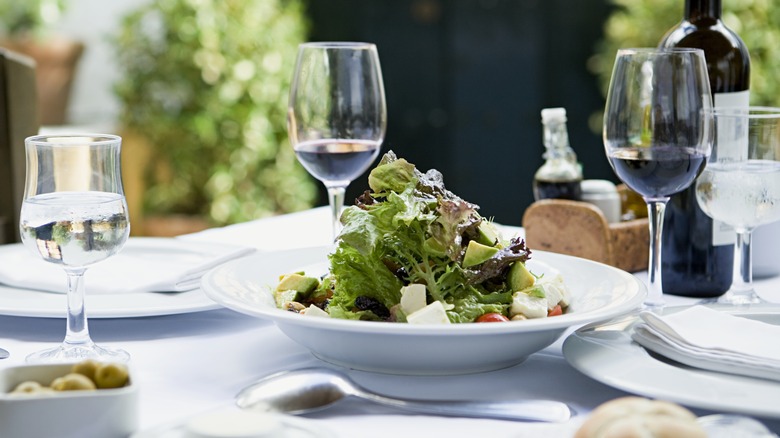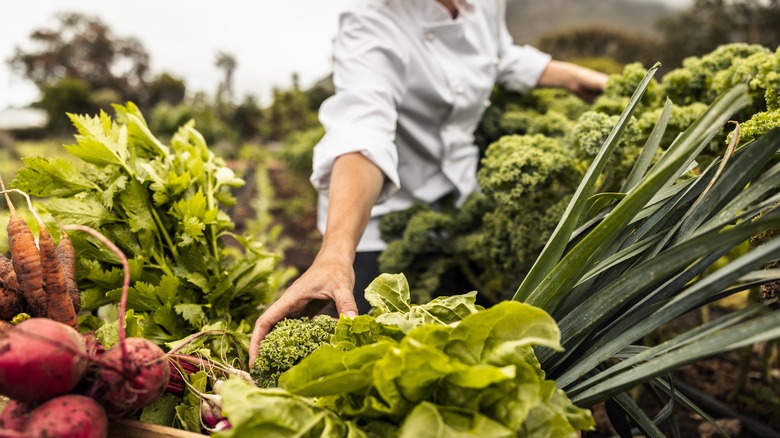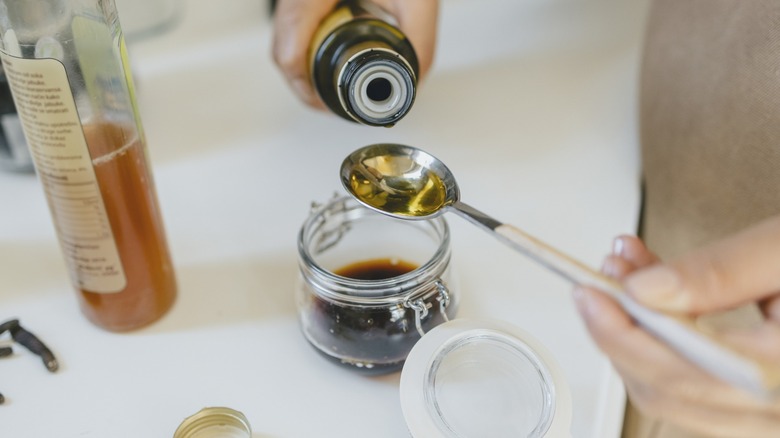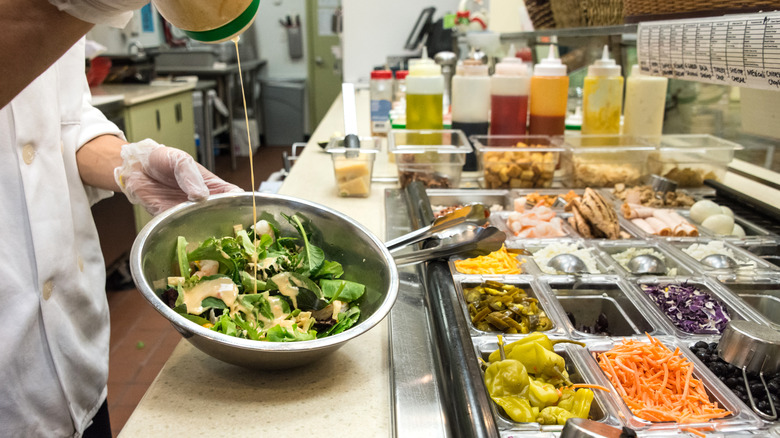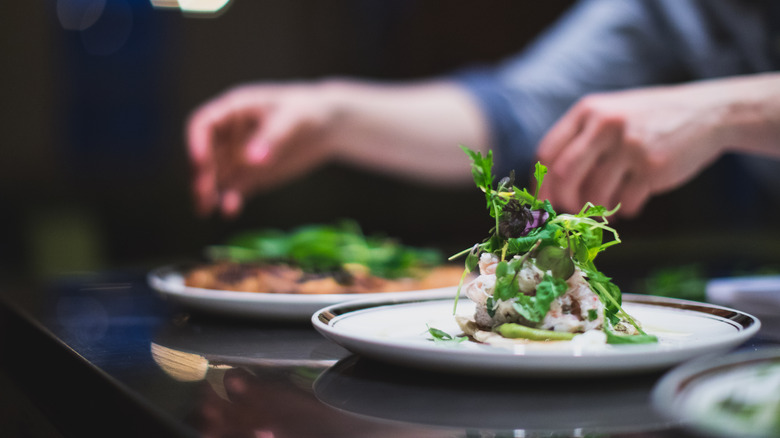The Reason Restaurant Salads Always Taste Better Than Yours
Despite how simple salads might seem, a lot of small details are involved in making one. If you've ever tried to recreate your favorite restaurant salad, it probably didn't come out quite how you hoped. Maybe the dressing didn't coat the leafy greens the way you like, or perhaps the flavors just weren't as fresh or vibrant. That's not necessarily your fault, though, as there's a good reason why restaurant salads are unrivaled. Turns out, there are a few professional salad-making principles worth applying in your own kitchen.
From the modern wedge to the classic Caesar salad, chefs are experts at combining a whole host of ingredients with lettuce. Part of that comes from creativity, as professional cooks are no stranger to experimenting with fun flavors and textural elements. But chefs are also armed with an arsenal of techniques to transform veggies into a perfectly dressed and delicious dish. A restaurant's salad-making process typically begins with choosing the best and freshest ingredients and creating a dressing from scratch. It's also essential to properly prep and season the lettuce and toppings thoroughly, minding texture and flavor along every step of the way. And, finally, ensuring ingredients are evenly distributed and plated nicely can take any salad from great to incredible.
So, if you want to step up your salad game, you may need to dedicate a little extra time and thoughtfulness to the dish. Here are a few things worth considering when trying to make a restaurant-quality salad.
Ingredient quality is a top priority
Restaurants are judicious about the quality of the ingredients used to prepare any dish, even a simple side salad. After all, no one wants to eat wilted lettuce and wrinkly bell peppers. When it comes to a plate packed with veggies, crisp and ripe ingredients are essential — and that starts with shopping.
Whether you get your greens at the farmer's market or the grocery store, the goal is to snag produce that's fresh and firm. That probably means skipping the pre-cut lettuce in favor of an organic head. The bagged stuff might be more convenient, but it's not usually the best available in terms of texture or flavor. Depending on when you're shopping for produce, be open-minded based on what's in season. This approach is also great for finding inspiration when building a salad from scratch. For instance, a shaved Brussels sprouts salad with chopped apples and roasted butternut squash is a cozy dish fit for fall, while a peppery yet bright peach, goat cheese, and spinach-arugula salad will shine during the summertime.
No matter what flavors you're after, be mindful not to go shopping for salad ingredients too far in advance. While you should always make sure to store produce properly, not using them promptly could lead to an unappetizing meal — an issue that many restaurants avoid by carefully managing inventory and frequently restocking. While a good homemade dressing goes a long way in improving a salad overall, condiments can't fix everything, especially mushy veggies past their prime.
Homemade dressing is hard to beat
While lettuce is the main component of your typical salad, the term "salad" actually comes from its shining star: the dressing. The word is related to the Latin "salata" (salted things), which refers to the ancient Romans' fondness of eating assorted raw but well-seasoned vegetables. These classical era salads were dressed with the same staple ingredients that most modern recipes use: oil, vinegar, and brine. After all, lettuce is great on its own, but it's also an important vehicle for rich, creamy, or tangy sauces.
Although there's nothing wrong with store-bought condiments, any restaurant salad worth its weight is tossed in homemade dressing. Thankfully, it's easy to prepare delicious dressings and vinaigrettes with the right ratio of ingredients. The basic formula consists of fat, acid, and salt, but there's room to switch specific components up. For instance, a standard Caesar dressing includes egg yolks, Parmesan, anchovies, garlic, salt, lemon juice, Dijon mustard, and oil. When making it from scratch, you decide whether the dressing has pre-grated cheese or freshly squeezed lemon juice. You can also make substitutions, say avocado for egg yolks or capers for anchovies. Since you don't have the same level of control over a bottled version's quality, it could be lacking in flavor and freshness. It's easier to make dressing exactly to your liking too, tasting as you go to notice what's missing so you can re-season accordingly — an essential part of professional salad prep.
From washing to tossing, proper salad prep is essential
In terms of seasoning, how restaurants handle and dress salad ingredients is given just as much care as deciding which ones to add. While you should always thoroughly wash produce — even the veggies that you plan to peel — it's essential to dry them well afterwards. A wet salad is often a culinary faux pas so this step is especially important for textural integrity. Wet leafy greens aren't appetizing, as they lose their crispness and salad dressing won't stick to them as well. If you don't have a salad spinner, recreate the drying centrifugal force effect with ordinary household objects or use a kitchen towel, taking care not to bruise the leafy greens. Additionally, seasoning all the ingredients, even the lettuce, can help to remove excess moisture from water-packed produce that would otherwise soak the salad. Salt and pepper also draw out the flavors of fresh veggies, adding depth to the dish.
The key to assembling a stellar salad is an extra-large bowl; this way, you aren't worried about making a mess when thoroughly mixing. Gently toss together the ingredients without crushing them, setting aside some extra toppings for serving. When it comes to dressing, some chefs add it to the bowl before the lettuce. This ensures all the leafy greens are evenly coated and any excess vinaigrette is left at the bottom. However, for thicker dressings, it may be best to gradually pour the condiment as you toss the salad to avoid over-dressing it.
The importance of purposeful plating and assembly for a restaurant-quality salad
Restaurant salads generally look as good as they taste. A fancy Michelin-star salad is bound to be delicately arranged and feature bright colors that pop through the vibrant greens or perhaps piled high to create an elegant yet impressively tall leafy tower. The last thing you want when serving a salad at home is to just dump it onto a plate. So when it comes to plating, texture and ingredient distribution is just as important as appearance.
The first step to successfully plating a restaurant-worthy salad should be taken before you even begin. To keep the lettuce and toppings crisp and refreshing, chill the serving plates or bowls. Once they're cold, begin building the salad's base, whether with tongs or by hand for any little adjustments. Start wide and work your way up, creating some height and building layers.
One of the most pleasant parts of eating a salad is achieving the perfect bite packed with all the toppings. Of course, forks can only stab through and scoop up so many ingredients, but if your salad has sliced strawberries, feta crumbles, and toasted walnuts, they should be present throughout the entire dish. When finishing the plating process, deliberately place extra un-tossed toppings for visual appeal, so anyone eating the salad sees everything they can expect to taste. After all, people eat with their eyes first — a fact that restaurants are keenly aware of, and you should be too when aspiring to their standard of quality.
